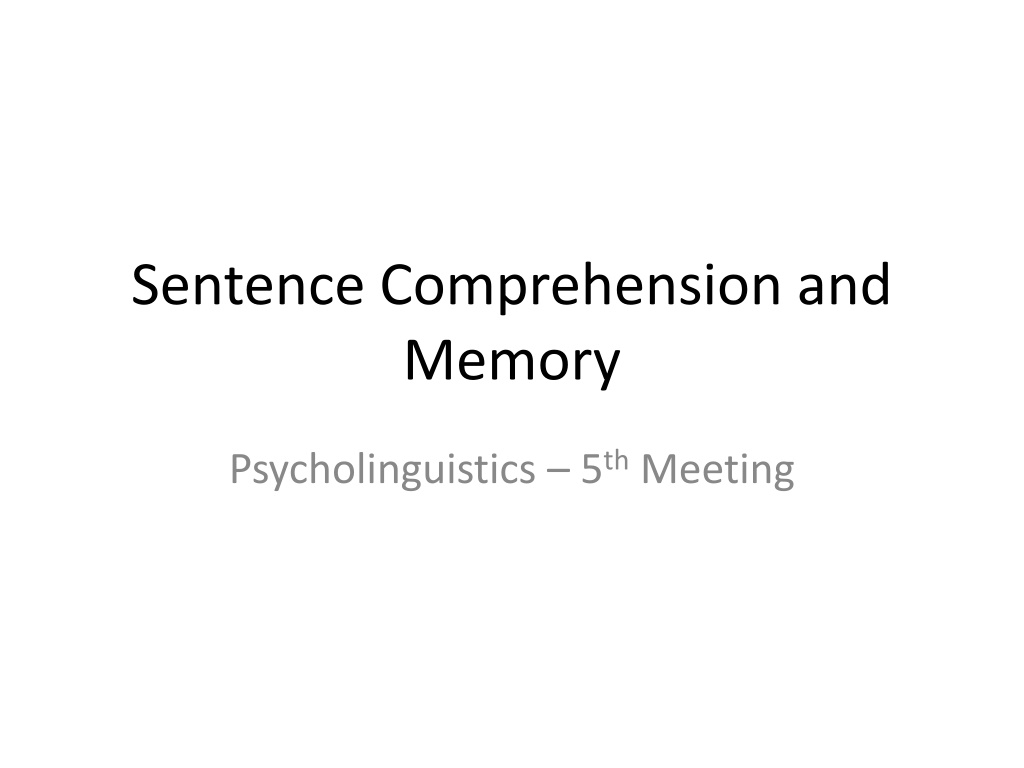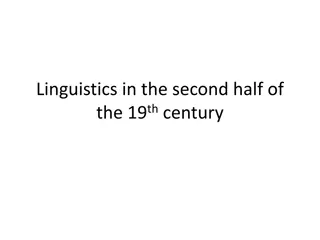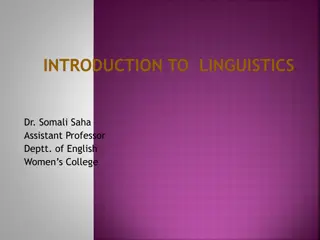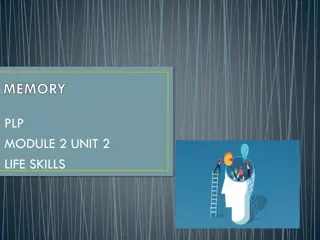Understanding Sentence Comprehension and Memory in Psycholinguistics
Sentence comprehension involves parsing, assigning linguistic categories, and utilizing syntactic, semantic, and pragmatic knowledge. The immediacy principle and wait-and-see approach play roles in the processing of sentences. Figurative language and the challenges in parsing sentences are also discussed in this informative content highlighting the complexities involved in comprehending sentences.
Download Presentation

Please find below an Image/Link to download the presentation.
The content on the website is provided AS IS for your information and personal use only. It may not be sold, licensed, or shared on other websites without obtaining consent from the author. Download presentation by click this link. If you encounter any issues during the download, it is possible that the publisher has removed the file from their server.
E N D
Presentation Transcript
Sentence Comprehension and Memory Psycholinguistics 5thMeeting
We are usually not aware of the sentence structure when we comprehend it. Some sentences are too difficult in meaning that we have to struggle hard to comprehend. Some sentences are clearer in meaning than in intent. We seldom remember the exact wording of the sentence we heard. Factors involved in the sentence comprehension process: syntactic, semantic and pragmatic.
Main Points Parsing is the process of assigning elements of surface structure to linguistic categories. Because of limitations in processing resources, we begin to parse sentences as we see or hear each word in a sentence. We use syntactic, semantic, and pragmatic knowledge to comprehend sentences. Figurative language is that literally means one thing but is taken to mean another. Although we may sometimes use literal meaning as a guide to figurative meaning, we can also comprehend figurative language directly. 3
Immediate Process of Sentences: Parsing S S NP NP Parsing Assign elements of its surface structure to linguistic categories. Results in phrase marker (a tree structure; Fig. 6.1) det N det The actor The S S S S NP VP NP VP det N V NP det N V The actor thanked The actor thanked det S the NP VP det N V NP Fig. 6.1 Five Stages in the parsing of a sentence. The actor thanked det N the audience 4
Two approaches of parsing: 1. Immediacy principle: when we first see or hear a word, we access its meaning from permanent memory, identify its likely referent, ad fit it into the syntactic structure of the sentence. 2. Wait-and-see approach: postpone interpreting a word or phrase until it is clearer.
Parsing: Immediacy Principle As we encounter a word in a sentence, we immediately make decisions about where to place the word into the phrase marker, although we sometimes postpone decisions (Just and Carpenter, 1980). Otherwise, the number of decisions involved in understanding even a sentence can overload our cognitive resources. (1) John bought the flower for Susan. for = to give to or not? If it s heard, flower has the other interpretation flour . Immediate processing may lead to errors in parsing. (2) The florist sent the flowers ... At this point sent the flowers looks like the main verb phrase. (3) The florist sent the flowers was very pleased. Sent the flowers is an embedded relative clause. We are surprised by the continuation in (3). 6
Parsing: Immediacy Principle We seem to use the immediacy approach more often because: 1. decisions in understanding can overload our cognitive resources. 2. we are often surprised by unexpected fragments in the sentence.
Parsing Strategies (1): Late Closure Strategy Attaching new items to the current constituent (Frazier, 1987; Frazier & Fodor, 1978; Kimball, 1973). (5) Tom said that Bill had taken the cleaning out yesterday. We tend to prefer attaching yesterday to the main clause Tom said than to the subsequent subordinate clause Bill had taken . (6) Jessie put the book Kathy was reading in the library We tend to prefer attaching in the library to the latter verb reading . The burden on working memory is reduced. Frazier and Rayner (1982) (7) Since jay always jogs a mile seems like a very short distance to him. Eye fixation times on the last few words were longer than on the earlier ones. This implies that the readers had misinterpreted a mile and had to make some later adjustments. garden path sentence (Ch. 1) 8
Parsing Strategies (2): Minimal Attachment Strategy Using the fewest syntactic nodes in the phrase marker (Frazier, 1987; Frazier & Fodor, 1978) (8) Ernie kissed Marcie and her sister We prefer to interpret her sister as a recipient of a kiss, rather than as the beginning of a new noun phrase. Frazier and Rayner (1982) (9) The city council argued the mayor s position forcefully. (10) The city council argued the mayor s position was incorrect. Reading times were faster for (9) than for (10) (Fig. 6.2). Fig. 6.2 S S (b) (a) Tree diagrams NP VP NP VP S V NP adv V NP VP The city council argued the mayor s position forcefully. The city council argued the mayor s position was incorrect. 9
Modular versus Interactive Models Modular Model: comprehension as a whole is the result of many different modules. Each devoted to a particular aspect of comprehension. Parsing is performed initially by a syntactic module not influenced by higher-order contextual variables. Contextual factors influence comprehension at a later stage.
Modular versus Interactive Models Interactive model: syntax and semantics interact during the comprehension process. For example, constraint-based model (MacDonald, 1994): We simultaneously use all available information in our initial parsing syntactic, lexical, discourse, as well as nonlinguistic, contextual information
Modularity vs Interactive Parsing Interactive support: 1. If you walk too near the runway, landing planes ARE/IS 2. If you've been trained as a pilot, landing planes IS/ARE Modular support: 3. The florist sent the flowers was very pleased. 4. The performer sent the flowers was very pleased. 12
Rayners Test (1983) Whether the plausibility of real-world events influenced the immediate parsing of sentences. Methods: measured eye fixations on segments of these sentences Findings: Clear garden path effects were found with both plausible and implausible sentences.
Rayners Test Examined structurally ambiguous sentences such as (11). (11) The florist sent the flowers was very pleased. (12) The florist sent the flowers to the elderly widow. (13) The florist who was sent the flowers was very pleased. The minimal attachment principle sent in (11) is the verb (MV), as in (12) Parsing is unrelated to the plausibility of real-world events (Rayner, Carlson and Frazier, 1983) (11) The florist sent the flowers was very pleased. (14) The performer sent the flowers was very pleased. Garden path effects (eye fixation) with both plausible (14) and implausible (11) sentences. 14
Sentence Comprehension Model 1. Parse the sentence 2. Look words up in mental lexicon as they are presented 3. Access meaning and grammatical categories (activating related nodes along the way) 4. Construct a syntactic representation [we use trees when we diagram them] 5. Sentence meaning is built up from the meaning of the component words and sentence structure 15
Figurative language George went through the roof. George got very angry. Birds of a feather flock together. Those of similar taste congregate in groups. 16
Types of figurative language Type Example My lawyer is a snake. Metaphor Some marriages are iceboxes. George went through the roof. Idiom She's turning over a new leaf with her diet. We need to get some fresh legs in the game. Metonymy The ham sandwich wants a Coke. Birds of a feather flock together. Proverb When the cat's away mice will play. Can you open the window? Indirect Speech Act Would you mind lending me five dollars? 17
Metaphor Metaphors consist of three main parts; tenor, vehicle, and ground. Ex) Billboards are warts on the landscape Similarity Between tenor and vehicle 18
Figurative language comprehension Pragmatic Theory: we comprehend figurative language by considering the literal meaning, then rejecting it Conceptual metaphor theory: we comprehend figurative language in terms of underlying conceptual metaphors. Class inclusion theories: metaphors are class inclusion statements 19
Grice's Maxims of Conversation 1. Quantity Be informative 2. Quality Be truthful 3. Relation Be relevant 4. Manner Be clear 20
Speech Acts: Function and Form Speech Act Sentence Type Function Form assertions declarative questions interrogative orders imperative requests imperative 21
Stage Model of the Interpretation of Indirect Speech Acts (Searle, 1975) 1. Listener extracts literal meaning. 2. Listener decides if the literal meaning is what was intended 3. If not, listener figures intent using context and communicative conventions 22
Conceptual metaphor Theory Metaphors are not creative expressions but rather instantiations of underlying conceptual metaphors. Ex) TIME IS MONEY. (You re wasting your time, How do you spend your time?) LOVE IS A JOURNEY. (Look how far we ve come, We re spinning our wheels, We ve hit a dead-end street) 23
Class Inclusion Theory Metaphors are class inclusion statements. Ex 1) The container held the apples ( = basket) The container held the cola. ( = glass or bottle) Instantiation Identifying a general term with a specific meaning 24
Class Inclusion Theory Metaphors also require a selective activation of information from the lexicon. What do two sentences have in common? ex ) The pianist is a butcher. The surgeon is a butcher. Negative evaluation, gross incompetence 25
Class Inclusion Theory Evidence Metaphors are nonreversible. Ex ) My job is a jail ( O ) . My jail is a job ( X ) We understand metaphors much the way we understand literal speech - by retrieving information from the lexicon, selecting the part that is relevant, and identifying the relationship between the lexical representations that have been retrieved. 26























